Accounting Perspectives on HR's Role in Long-Term Sustainable Value
VerifiedAdded on 2023/06/05
|10
|2256
|138
Essay
AI Summary
This essay discusses the critical role of human resources in creating long-term sustainable value for stakeholders within organizations. It highlights the increasing importance of integrating sustainability into business models and the challenges companies face in implementing sustainable practices, such as lack of top-level management support and difficulty in measuring returns from sustainability investments. The essay emphasizes how HR can facilitate the enforcement of sustainable business practices by creating a sustainable vision, building united leadership, and implementing governance mechanisms. It also touches upon the alignment of HR processes with sustainability goals, such as value-based employee-volunteering programs and ensuring transparent procedures for hiring, performance management, and motivation, ultimately linking HRM policies to business performance and stakeholder value. The essay concludes by recognizing the shift towards attracting external stakeholders and the importance of sustainable human resource development in achieving long-term organizational success.

ACCOUNTING
Paraphrase This Document
Need a fresh take? Get an instant paraphrase of this document with our AI Paraphraser

ACCOUNTING: 1
Contents
Introduction...........................................................................................................................................2
Human Resources system creates long-term sustainable value for stakeholders...................................2
Evidence and reasons............................................................................................................................5
Conclusion.............................................................................................................................................6
References.............................................................................................................................................7
Contents
Introduction...........................................................................................................................................2
Human Resources system creates long-term sustainable value for stakeholders...................................2
Evidence and reasons............................................................................................................................5
Conclusion.............................................................................................................................................6
References.............................................................................................................................................7
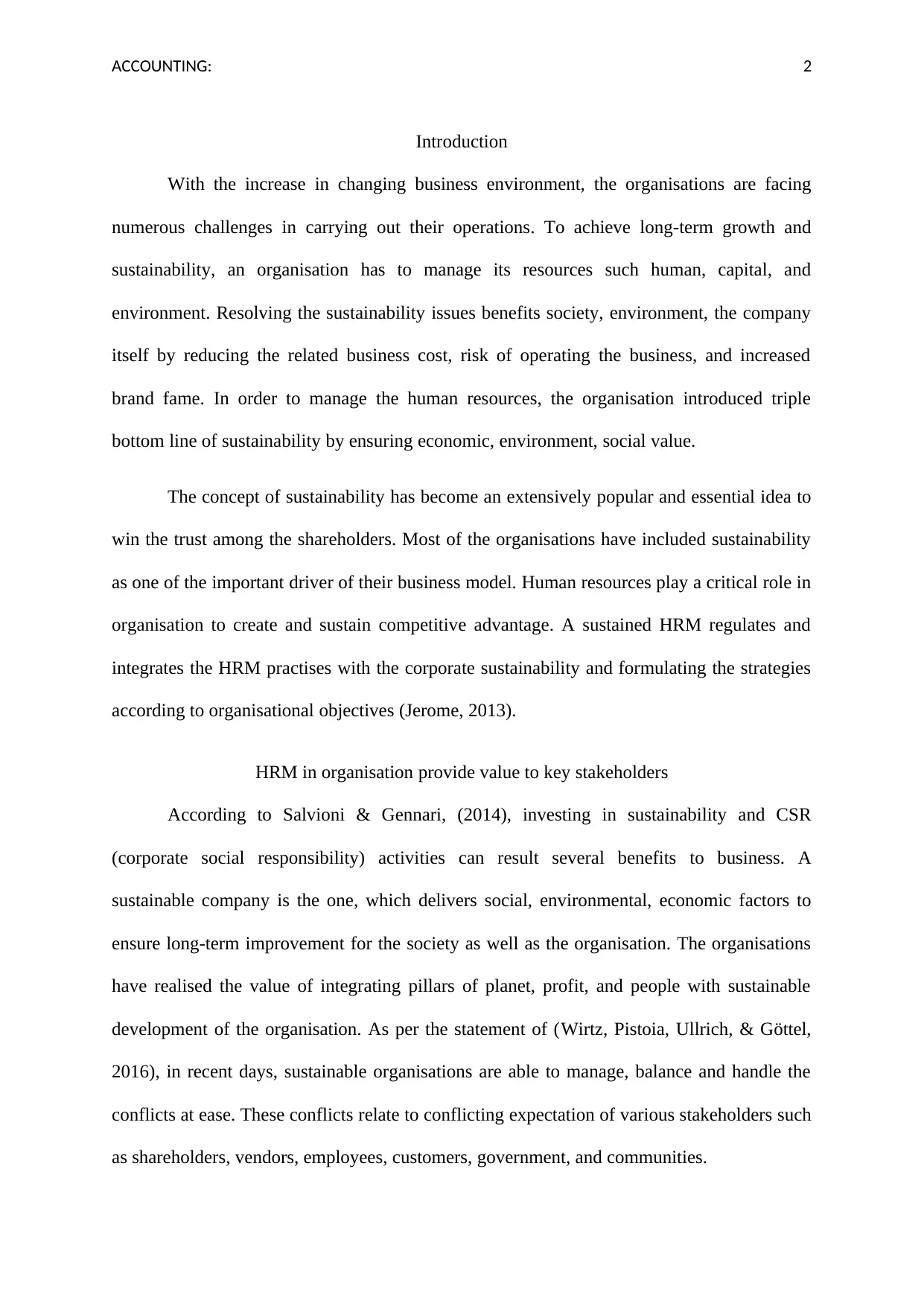
ACCOUNTING: 2
Introduction
With the increase in changing business environment, the organisations are facing
numerous challenges in carrying out their operations. To achieve long-term growth and
sustainability, an organisation has to manage its resources such human, capital, and
environment. Resolving the sustainability issues benefits society, environment, the company
itself by reducing the related business cost, risk of operating the business, and increased
brand fame. In order to manage the human resources, the organisation introduced triple
bottom line of sustainability by ensuring economic, environment, social value.
The concept of sustainability has become an extensively popular and essential idea to
win the trust among the shareholders. Most of the organisations have included sustainability
as one of the important driver of their business model. Human resources play a critical role in
organisation to create and sustain competitive advantage. A sustained HRM regulates and
integrates the HRM practises with the corporate sustainability and formulating the strategies
according to organisational objectives (Jerome, 2013).
HRM in organisation provide value to key stakeholders
According to Salvioni & Gennari, (2014), investing in sustainability and CSR
(corporate social responsibility) activities can result several benefits to business. A
sustainable company is the one, which delivers social, environmental, economic factors to
ensure long-term improvement for the society as well as the organisation. The organisations
have realised the value of integrating pillars of planet, profit, and people with sustainable
development of the organisation. As per the statement of (Wirtz, Pistoia, Ullrich, & Göttel,
2016), in recent days, sustainable organisations are able to manage, balance and handle the
conflicts at ease. These conflicts relate to conflicting expectation of various stakeholders such
as shareholders, vendors, employees, customers, government, and communities.
Introduction
With the increase in changing business environment, the organisations are facing
numerous challenges in carrying out their operations. To achieve long-term growth and
sustainability, an organisation has to manage its resources such human, capital, and
environment. Resolving the sustainability issues benefits society, environment, the company
itself by reducing the related business cost, risk of operating the business, and increased
brand fame. In order to manage the human resources, the organisation introduced triple
bottom line of sustainability by ensuring economic, environment, social value.
The concept of sustainability has become an extensively popular and essential idea to
win the trust among the shareholders. Most of the organisations have included sustainability
as one of the important driver of their business model. Human resources play a critical role in
organisation to create and sustain competitive advantage. A sustained HRM regulates and
integrates the HRM practises with the corporate sustainability and formulating the strategies
according to organisational objectives (Jerome, 2013).
HRM in organisation provide value to key stakeholders
According to Salvioni & Gennari, (2014), investing in sustainability and CSR
(corporate social responsibility) activities can result several benefits to business. A
sustainable company is the one, which delivers social, environmental, economic factors to
ensure long-term improvement for the society as well as the organisation. The organisations
have realised the value of integrating pillars of planet, profit, and people with sustainable
development of the organisation. As per the statement of (Wirtz, Pistoia, Ullrich, & Göttel,
2016), in recent days, sustainable organisations are able to manage, balance and handle the
conflicts at ease. These conflicts relate to conflicting expectation of various stakeholders such
as shareholders, vendors, employees, customers, government, and communities.
⊘ This is a preview!⊘
Do you want full access?
Subscribe today to unlock all pages.

Trusted by 1+ million students worldwide
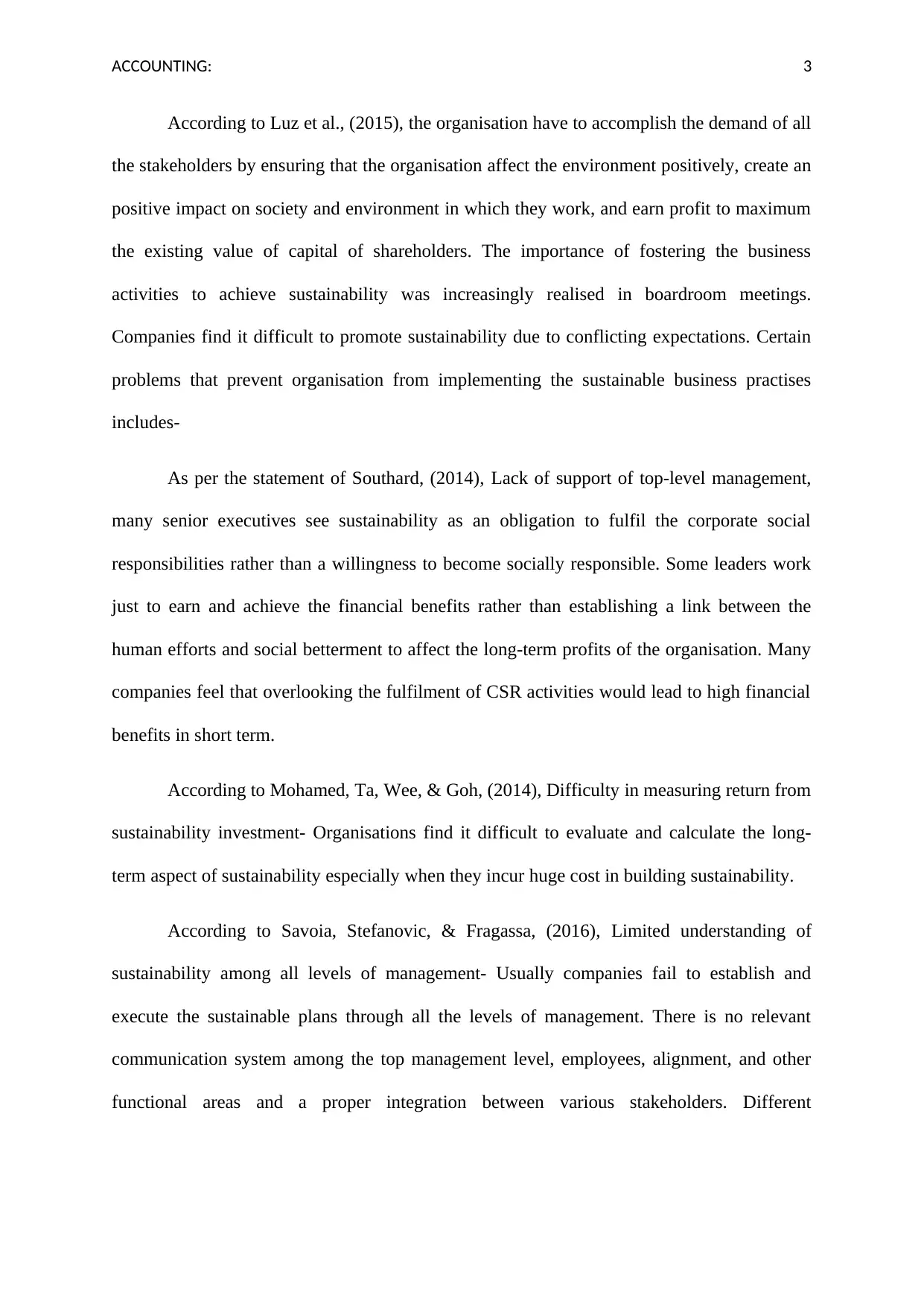
ACCOUNTING: 3
According to Luz et al., (2015), the organisation have to accomplish the demand of all
the stakeholders by ensuring that the organisation affect the environment positively, create an
positive impact on society and environment in which they work, and earn profit to maximum
the existing value of capital of shareholders. The importance of fostering the business
activities to achieve sustainability was increasingly realised in boardroom meetings.
Companies find it difficult to promote sustainability due to conflicting expectations. Certain
problems that prevent organisation from implementing the sustainable business practises
includes-
As per the statement of Southard, (2014), Lack of support of top-level management,
many senior executives see sustainability as an obligation to fulfil the corporate social
responsibilities rather than a willingness to become socially responsible. Some leaders work
just to earn and achieve the financial benefits rather than establishing a link between the
human efforts and social betterment to affect the long-term profits of the organisation. Many
companies feel that overlooking the fulfilment of CSR activities would lead to high financial
benefits in short term.
According to Mohamed, Ta, Wee, & Goh, (2014), Difficulty in measuring return from
sustainability investment- Organisations find it difficult to evaluate and calculate the long-
term aspect of sustainability especially when they incur huge cost in building sustainability.
According to Savoia, Stefanovic, & Fragassa, (2016), Limited understanding of
sustainability among all levels of management- Usually companies fail to establish and
execute the sustainable plans through all the levels of management. There is no relevant
communication system among the top management level, employees, alignment, and other
functional areas and a proper integration between various stakeholders. Different
According to Luz et al., (2015), the organisation have to accomplish the demand of all
the stakeholders by ensuring that the organisation affect the environment positively, create an
positive impact on society and environment in which they work, and earn profit to maximum
the existing value of capital of shareholders. The importance of fostering the business
activities to achieve sustainability was increasingly realised in boardroom meetings.
Companies find it difficult to promote sustainability due to conflicting expectations. Certain
problems that prevent organisation from implementing the sustainable business practises
includes-
As per the statement of Southard, (2014), Lack of support of top-level management,
many senior executives see sustainability as an obligation to fulfil the corporate social
responsibilities rather than a willingness to become socially responsible. Some leaders work
just to earn and achieve the financial benefits rather than establishing a link between the
human efforts and social betterment to affect the long-term profits of the organisation. Many
companies feel that overlooking the fulfilment of CSR activities would lead to high financial
benefits in short term.
According to Mohamed, Ta, Wee, & Goh, (2014), Difficulty in measuring return from
sustainability investment- Organisations find it difficult to evaluate and calculate the long-
term aspect of sustainability especially when they incur huge cost in building sustainability.
According to Savoia, Stefanovic, & Fragassa, (2016), Limited understanding of
sustainability among all levels of management- Usually companies fail to establish and
execute the sustainable plans through all the levels of management. There is no relevant
communication system among the top management level, employees, alignment, and other
functional areas and a proper integration between various stakeholders. Different
Paraphrase This Document
Need a fresh take? Get an instant paraphrase of this document with our AI Paraphraser
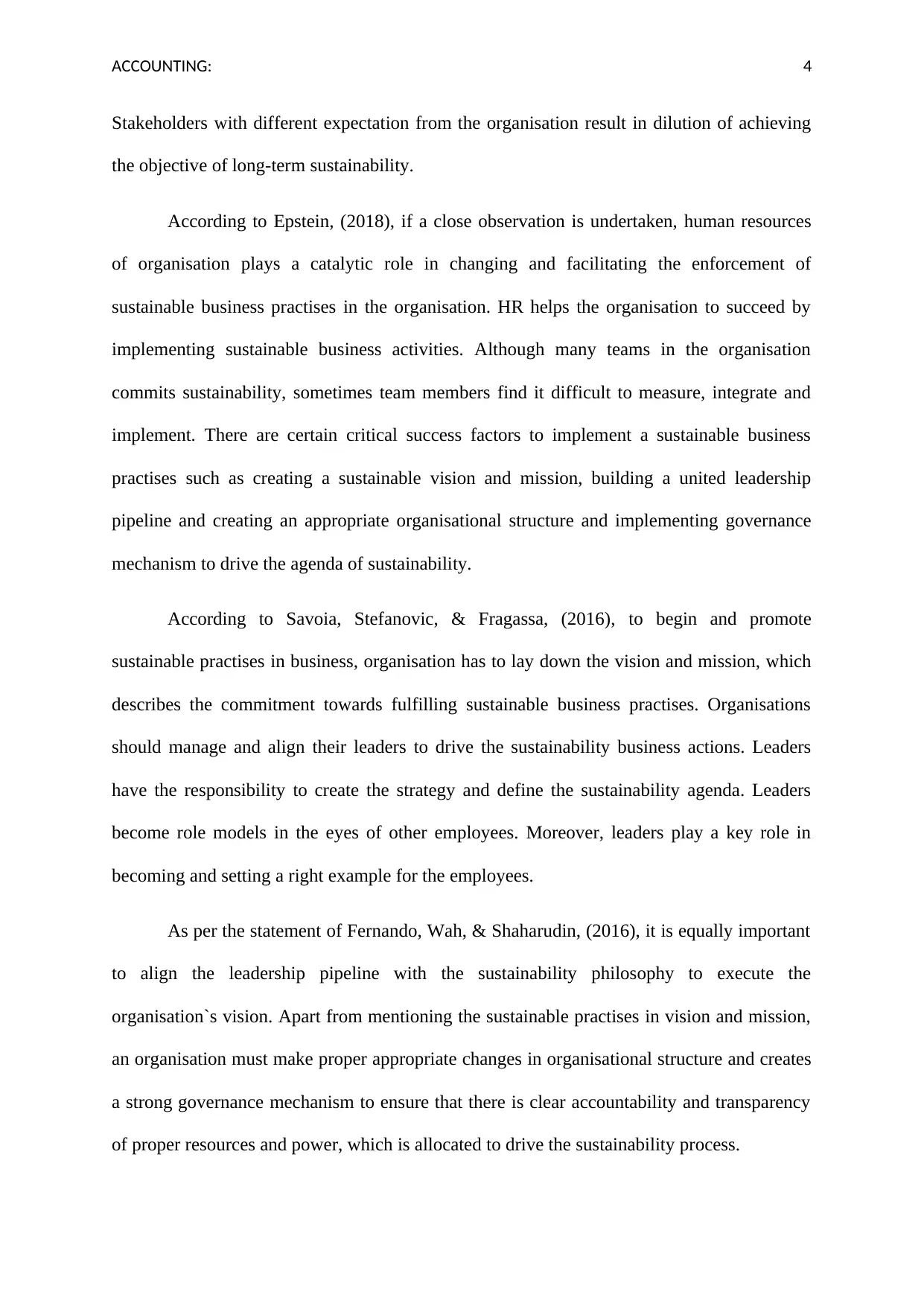
ACCOUNTING: 4
Stakeholders with different expectation from the organisation result in dilution of achieving
the objective of long-term sustainability.
According to Epstein, (2018), if a close observation is undertaken, human resources
of organisation plays a catalytic role in changing and facilitating the enforcement of
sustainable business practises in the organisation. HR helps the organisation to succeed by
implementing sustainable business activities. Although many teams in the organisation
commits sustainability, sometimes team members find it difficult to measure, integrate and
implement. There are certain critical success factors to implement a sustainable business
practises such as creating a sustainable vision and mission, building a united leadership
pipeline and creating an appropriate organisational structure and implementing governance
mechanism to drive the agenda of sustainability.
According to Savoia, Stefanovic, & Fragassa, (2016), to begin and promote
sustainable practises in business, organisation has to lay down the vision and mission, which
describes the commitment towards fulfilling sustainable business practises. Organisations
should manage and align their leaders to drive the sustainability business actions. Leaders
have the responsibility to create the strategy and define the sustainability agenda. Leaders
become role models in the eyes of other employees. Moreover, leaders play a key role in
becoming and setting a right example for the employees.
As per the statement of Fernando, Wah, & Shaharudin, (2016), it is equally important
to align the leadership pipeline with the sustainability philosophy to execute the
organisation`s vision. Apart from mentioning the sustainable practises in vision and mission,
an organisation must make proper appropriate changes in organisational structure and creates
a strong governance mechanism to ensure that there is clear accountability and transparency
of proper resources and power, which is allocated to drive the sustainability process.
Stakeholders with different expectation from the organisation result in dilution of achieving
the objective of long-term sustainability.
According to Epstein, (2018), if a close observation is undertaken, human resources
of organisation plays a catalytic role in changing and facilitating the enforcement of
sustainable business practises in the organisation. HR helps the organisation to succeed by
implementing sustainable business activities. Although many teams in the organisation
commits sustainability, sometimes team members find it difficult to measure, integrate and
implement. There are certain critical success factors to implement a sustainable business
practises such as creating a sustainable vision and mission, building a united leadership
pipeline and creating an appropriate organisational structure and implementing governance
mechanism to drive the agenda of sustainability.
According to Savoia, Stefanovic, & Fragassa, (2016), to begin and promote
sustainable practises in business, organisation has to lay down the vision and mission, which
describes the commitment towards fulfilling sustainable business practises. Organisations
should manage and align their leaders to drive the sustainability business actions. Leaders
have the responsibility to create the strategy and define the sustainability agenda. Leaders
become role models in the eyes of other employees. Moreover, leaders play a key role in
becoming and setting a right example for the employees.
As per the statement of Fernando, Wah, & Shaharudin, (2016), it is equally important
to align the leadership pipeline with the sustainability philosophy to execute the
organisation`s vision. Apart from mentioning the sustainable practises in vision and mission,
an organisation must make proper appropriate changes in organisational structure and creates
a strong governance mechanism to ensure that there is clear accountability and transparency
of proper resources and power, which is allocated to drive the sustainability process.
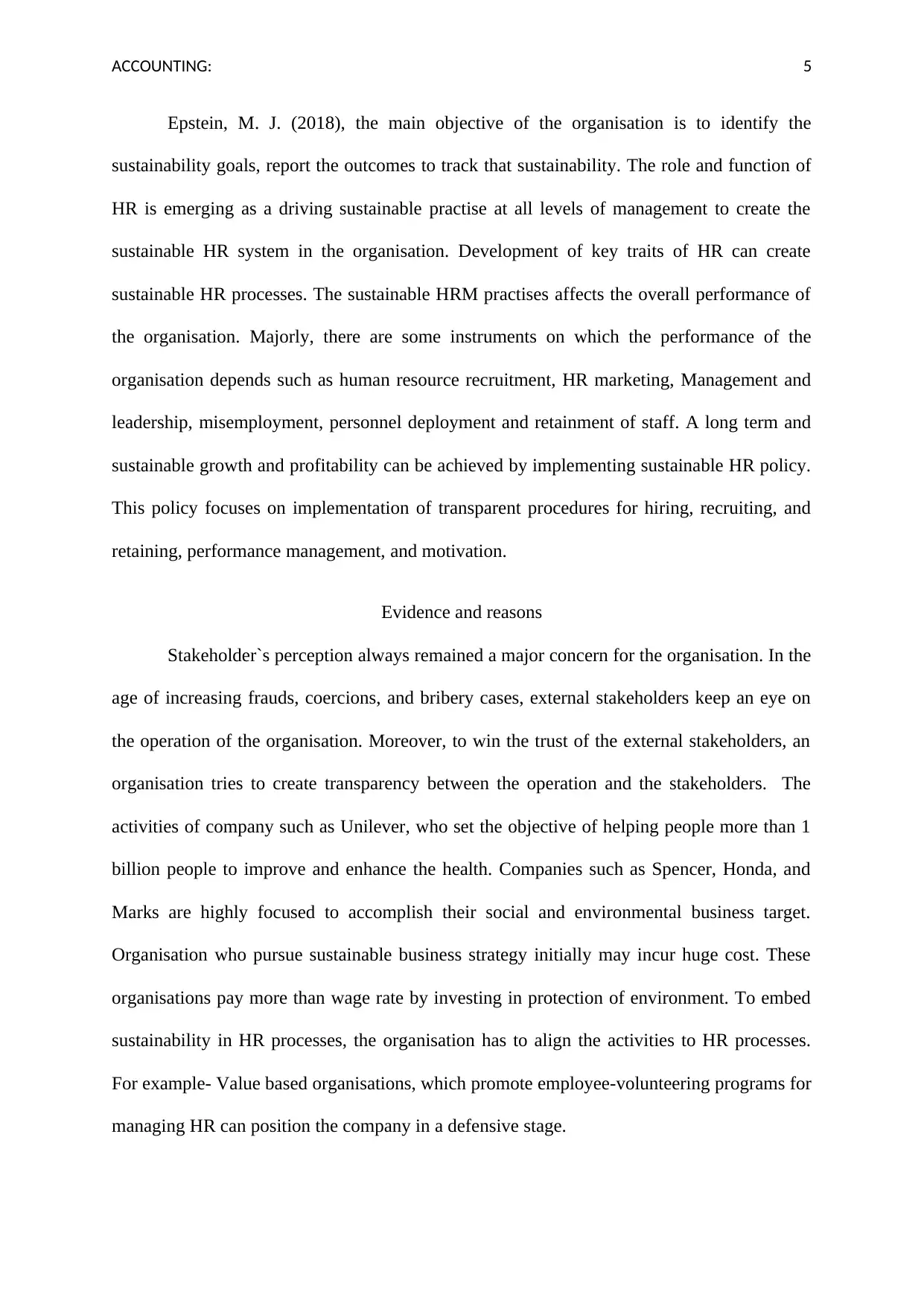
ACCOUNTING: 5
Epstein, M. J. (2018), the main objective of the organisation is to identify the
sustainability goals, report the outcomes to track that sustainability. The role and function of
HR is emerging as a driving sustainable practise at all levels of management to create the
sustainable HR system in the organisation. Development of key traits of HR can create
sustainable HR processes. The sustainable HRM practises affects the overall performance of
the organisation. Majorly, there are some instruments on which the performance of the
organisation depends such as human resource recruitment, HR marketing, Management and
leadership, misemployment, personnel deployment and retainment of staff. A long term and
sustainable growth and profitability can be achieved by implementing sustainable HR policy.
This policy focuses on implementation of transparent procedures for hiring, recruiting, and
retaining, performance management, and motivation.
Evidence and reasons
Stakeholder`s perception always remained a major concern for the organisation. In the
age of increasing frauds, coercions, and bribery cases, external stakeholders keep an eye on
the operation of the organisation. Moreover, to win the trust of the external stakeholders, an
organisation tries to create transparency between the operation and the stakeholders. The
activities of company such as Unilever, who set the objective of helping people more than 1
billion people to improve and enhance the health. Companies such as Spencer, Honda, and
Marks are highly focused to accomplish their social and environmental business target.
Organisation who pursue sustainable business strategy initially may incur huge cost. These
organisations pay more than wage rate by investing in protection of environment. To embed
sustainability in HR processes, the organisation has to align the activities to HR processes.
For example- Value based organisations, which promote employee-volunteering programs for
managing HR can position the company in a defensive stage.
Epstein, M. J. (2018), the main objective of the organisation is to identify the
sustainability goals, report the outcomes to track that sustainability. The role and function of
HR is emerging as a driving sustainable practise at all levels of management to create the
sustainable HR system in the organisation. Development of key traits of HR can create
sustainable HR processes. The sustainable HRM practises affects the overall performance of
the organisation. Majorly, there are some instruments on which the performance of the
organisation depends such as human resource recruitment, HR marketing, Management and
leadership, misemployment, personnel deployment and retainment of staff. A long term and
sustainable growth and profitability can be achieved by implementing sustainable HR policy.
This policy focuses on implementation of transparent procedures for hiring, recruiting, and
retaining, performance management, and motivation.
Evidence and reasons
Stakeholder`s perception always remained a major concern for the organisation. In the
age of increasing frauds, coercions, and bribery cases, external stakeholders keep an eye on
the operation of the organisation. Moreover, to win the trust of the external stakeholders, an
organisation tries to create transparency between the operation and the stakeholders. The
activities of company such as Unilever, who set the objective of helping people more than 1
billion people to improve and enhance the health. Companies such as Spencer, Honda, and
Marks are highly focused to accomplish their social and environmental business target.
Organisation who pursue sustainable business strategy initially may incur huge cost. These
organisations pay more than wage rate by investing in protection of environment. To embed
sustainability in HR processes, the organisation has to align the activities to HR processes.
For example- Value based organisations, which promote employee-volunteering programs for
managing HR can position the company in a defensive stage.
⊘ This is a preview!⊘
Do you want full access?
Subscribe today to unlock all pages.

Trusted by 1+ million students worldwide
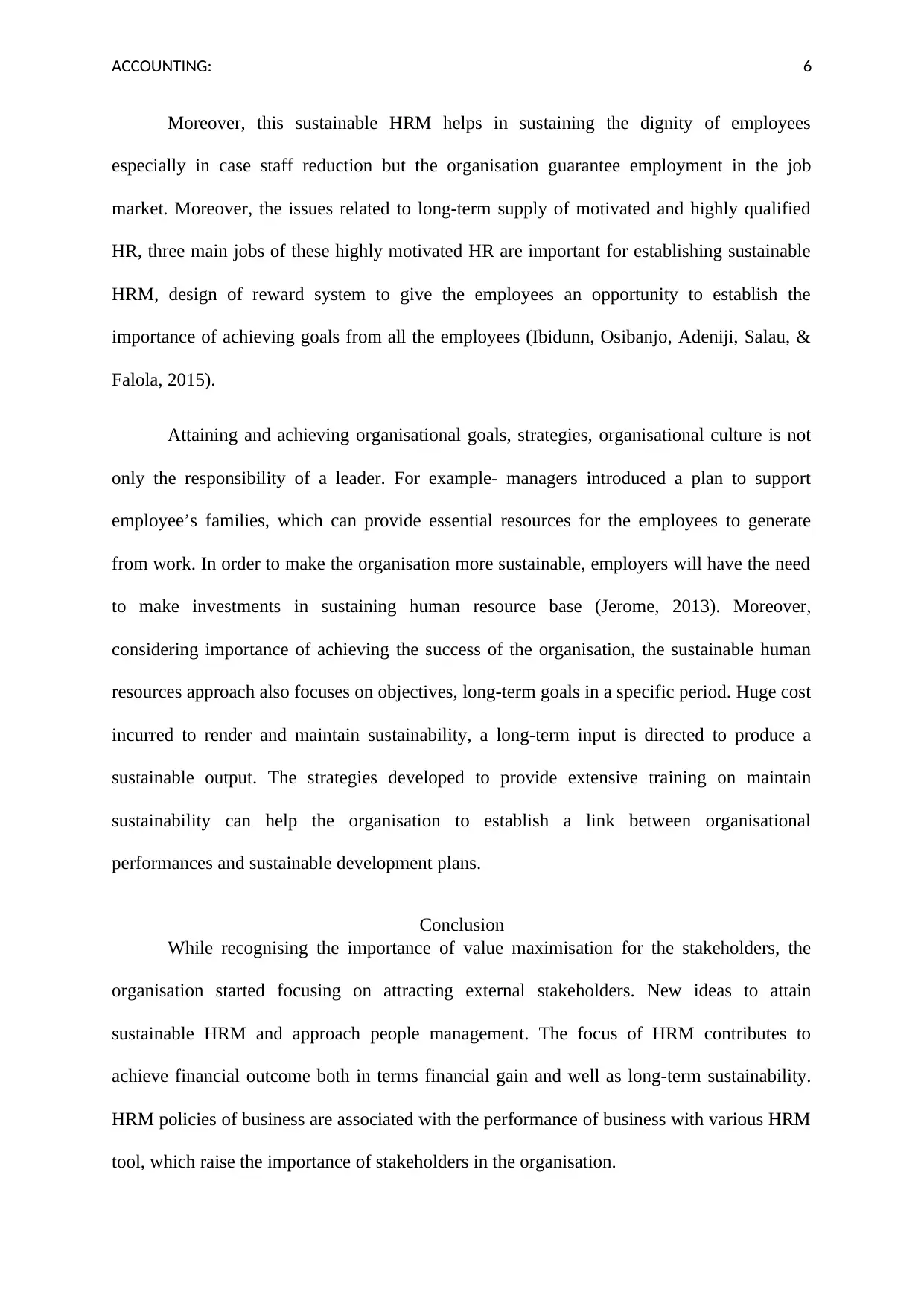
ACCOUNTING: 6
Moreover, this sustainable HRM helps in sustaining the dignity of employees
especially in case staff reduction but the organisation guarantee employment in the job
market. Moreover, the issues related to long-term supply of motivated and highly qualified
HR, three main jobs of these highly motivated HR are important for establishing sustainable
HRM, design of reward system to give the employees an opportunity to establish the
importance of achieving goals from all the employees (Ibidunn, Osibanjo, Adeniji, Salau, &
Falola, 2015).
Attaining and achieving organisational goals, strategies, organisational culture is not
only the responsibility of a leader. For example- managers introduced a plan to support
employee’s families, which can provide essential resources for the employees to generate
from work. In order to make the organisation more sustainable, employers will have the need
to make investments in sustaining human resource base (Jerome, 2013). Moreover,
considering importance of achieving the success of the organisation, the sustainable human
resources approach also focuses on objectives, long-term goals in a specific period. Huge cost
incurred to render and maintain sustainability, a long-term input is directed to produce a
sustainable output. The strategies developed to provide extensive training on maintain
sustainability can help the organisation to establish a link between organisational
performances and sustainable development plans.
Conclusion
While recognising the importance of value maximisation for the stakeholders, the
organisation started focusing on attracting external stakeholders. New ideas to attain
sustainable HRM and approach people management. The focus of HRM contributes to
achieve financial outcome both in terms financial gain and well as long-term sustainability.
HRM policies of business are associated with the performance of business with various HRM
tool, which raise the importance of stakeholders in the organisation.
Moreover, this sustainable HRM helps in sustaining the dignity of employees
especially in case staff reduction but the organisation guarantee employment in the job
market. Moreover, the issues related to long-term supply of motivated and highly qualified
HR, three main jobs of these highly motivated HR are important for establishing sustainable
HRM, design of reward system to give the employees an opportunity to establish the
importance of achieving goals from all the employees (Ibidunn, Osibanjo, Adeniji, Salau, &
Falola, 2015).
Attaining and achieving organisational goals, strategies, organisational culture is not
only the responsibility of a leader. For example- managers introduced a plan to support
employee’s families, which can provide essential resources for the employees to generate
from work. In order to make the organisation more sustainable, employers will have the need
to make investments in sustaining human resource base (Jerome, 2013). Moreover,
considering importance of achieving the success of the organisation, the sustainable human
resources approach also focuses on objectives, long-term goals in a specific period. Huge cost
incurred to render and maintain sustainability, a long-term input is directed to produce a
sustainable output. The strategies developed to provide extensive training on maintain
sustainability can help the organisation to establish a link between organisational
performances and sustainable development plans.
Conclusion
While recognising the importance of value maximisation for the stakeholders, the
organisation started focusing on attracting external stakeholders. New ideas to attain
sustainable HRM and approach people management. The focus of HRM contributes to
achieve financial outcome both in terms financial gain and well as long-term sustainability.
HRM policies of business are associated with the performance of business with various HRM
tool, which raise the importance of stakeholders in the organisation.
Paraphrase This Document
Need a fresh take? Get an instant paraphrase of this document with our AI Paraphraser
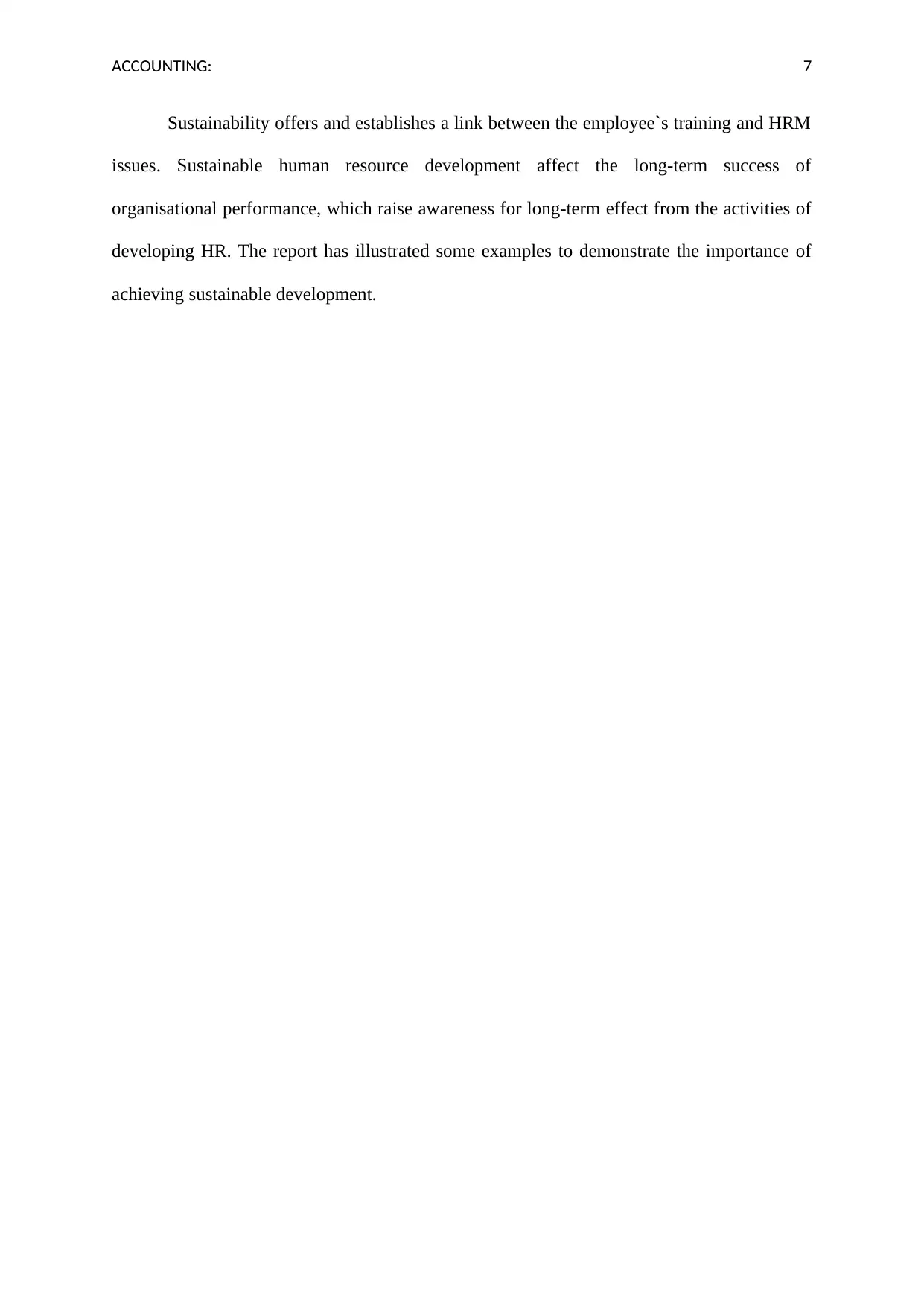
ACCOUNTING: 7
Sustainability offers and establishes a link between the employee`s training and HRM
issues. Sustainable human resource development affect the long-term success of
organisational performance, which raise awareness for long-term effect from the activities of
developing HR. The report has illustrated some examples to demonstrate the importance of
achieving sustainable development.
Sustainability offers and establishes a link between the employee`s training and HRM
issues. Sustainable human resource development affect the long-term success of
organisational performance, which raise awareness for long-term effect from the activities of
developing HR. The report has illustrated some examples to demonstrate the importance of
achieving sustainable development.
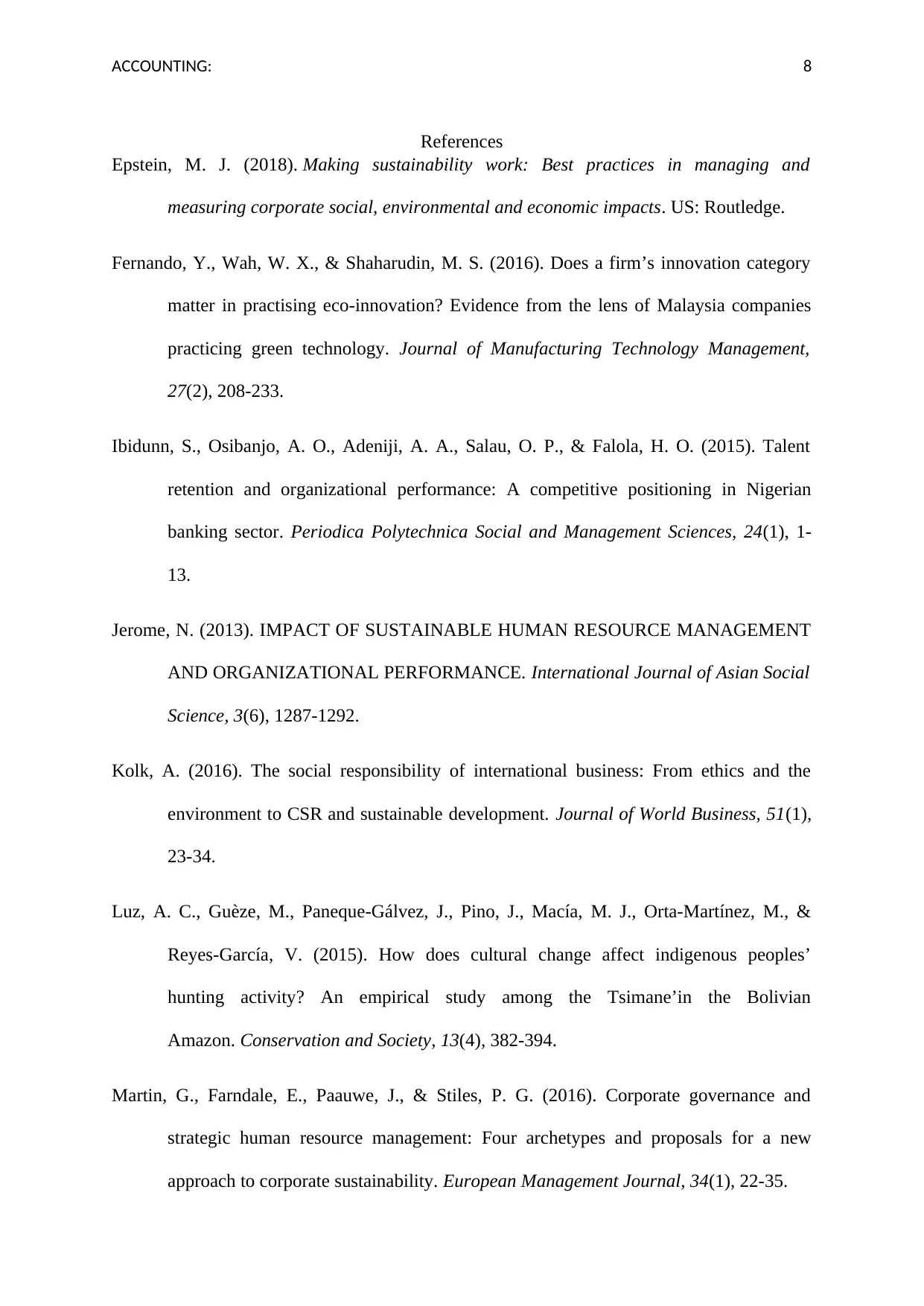
ACCOUNTING: 8
References
Epstein, M. J. (2018). Making sustainability work: Best practices in managing and
measuring corporate social, environmental and economic impacts. US: Routledge.
Fernando, Y., Wah, W. X., & Shaharudin, M. S. (2016). Does a firm’s innovation category
matter in practising eco-innovation? Evidence from the lens of Malaysia companies
practicing green technology. Journal of Manufacturing Technology Management,
27(2), 208-233.
Ibidunn, S., Osibanjo, A. O., Adeniji, A. A., Salau, O. P., & Falola, H. O. (2015). Talent
retention and organizational performance: A competitive positioning in Nigerian
banking sector. Periodica Polytechnica Social and Management Sciences, 24(1), 1-
13.
Jerome, N. (2013). IMPACT OF SUSTAINABLE HUMAN RESOURCE MANAGEMENT
AND ORGANIZATIONAL PERFORMANCE. International Journal of Asian Social
Science, 3(6), 1287-1292.
Kolk, A. (2016). The social responsibility of international business: From ethics and the
environment to CSR and sustainable development. Journal of World Business, 51(1),
23-34.
Luz, A. C., Guèze, M., Paneque-Gálvez, J., Pino, J., Macía, M. J., Orta-Martínez, M., &
Reyes-García, V. (2015). How does cultural change affect indigenous peoples’
hunting activity? An empirical study among the Tsimane’in the Bolivian
Amazon. Conservation and Society, 13(4), 382-394.
Martin, G., Farndale, E., Paauwe, J., & Stiles, P. G. (2016). Corporate governance and
strategic human resource management: Four archetypes and proposals for a new
approach to corporate sustainability. European Management Journal, 34(1), 22-35.
References
Epstein, M. J. (2018). Making sustainability work: Best practices in managing and
measuring corporate social, environmental and economic impacts. US: Routledge.
Fernando, Y., Wah, W. X., & Shaharudin, M. S. (2016). Does a firm’s innovation category
matter in practising eco-innovation? Evidence from the lens of Malaysia companies
practicing green technology. Journal of Manufacturing Technology Management,
27(2), 208-233.
Ibidunn, S., Osibanjo, A. O., Adeniji, A. A., Salau, O. P., & Falola, H. O. (2015). Talent
retention and organizational performance: A competitive positioning in Nigerian
banking sector. Periodica Polytechnica Social and Management Sciences, 24(1), 1-
13.
Jerome, N. (2013). IMPACT OF SUSTAINABLE HUMAN RESOURCE MANAGEMENT
AND ORGANIZATIONAL PERFORMANCE. International Journal of Asian Social
Science, 3(6), 1287-1292.
Kolk, A. (2016). The social responsibility of international business: From ethics and the
environment to CSR and sustainable development. Journal of World Business, 51(1),
23-34.
Luz, A. C., Guèze, M., Paneque-Gálvez, J., Pino, J., Macía, M. J., Orta-Martínez, M., &
Reyes-García, V. (2015). How does cultural change affect indigenous peoples’
hunting activity? An empirical study among the Tsimane’in the Bolivian
Amazon. Conservation and Society, 13(4), 382-394.
Martin, G., Farndale, E., Paauwe, J., & Stiles, P. G. (2016). Corporate governance and
strategic human resource management: Four archetypes and proposals for a new
approach to corporate sustainability. European Management Journal, 34(1), 22-35.
⊘ This is a preview!⊘
Do you want full access?
Subscribe today to unlock all pages.

Trusted by 1+ million students worldwide
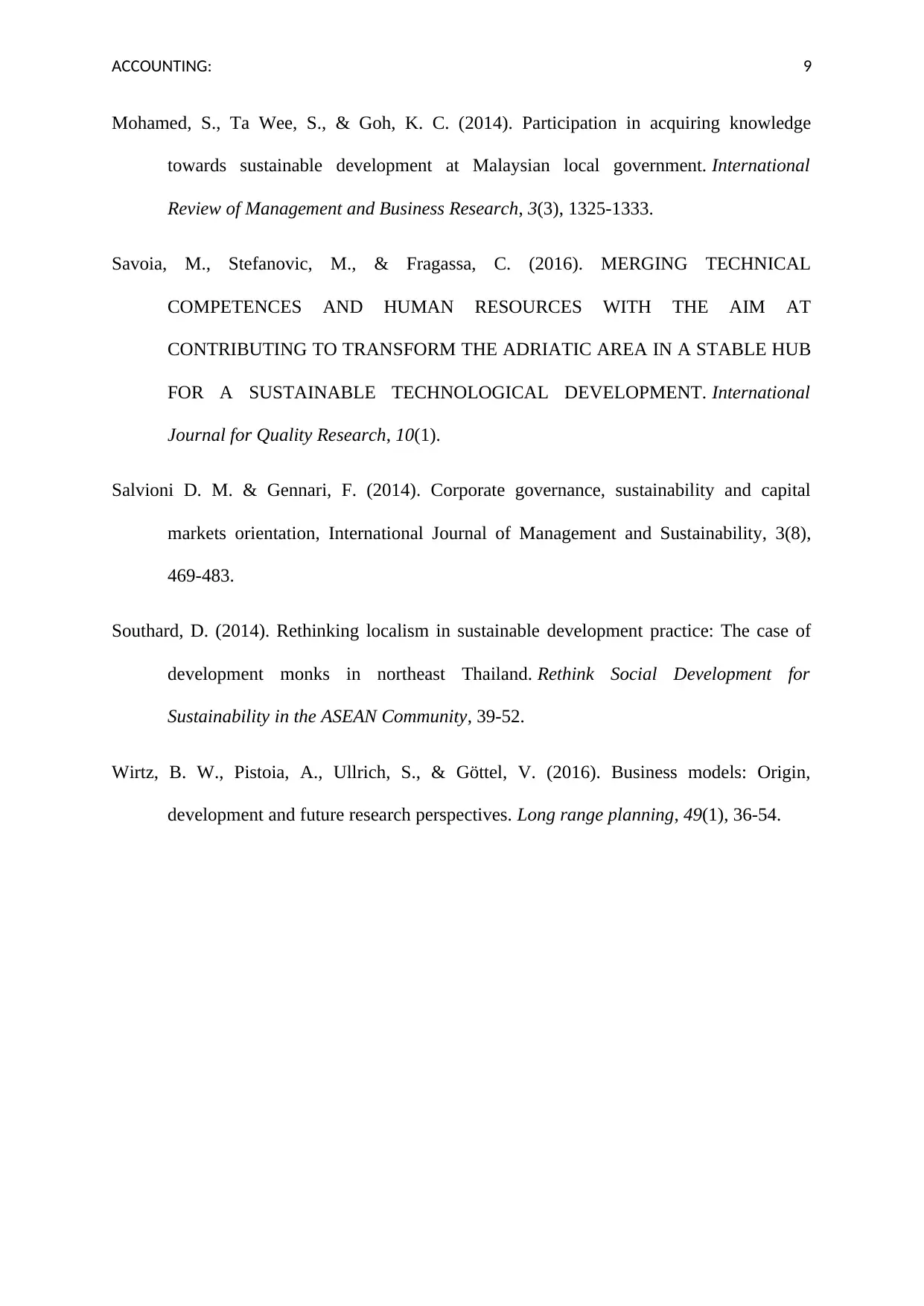
ACCOUNTING: 9
Mohamed, S., Ta Wee, S., & Goh, K. C. (2014). Participation in acquiring knowledge
towards sustainable development at Malaysian local government. International
Review of Management and Business Research, 3(3), 1325-1333.
Savoia, M., Stefanovic, M., & Fragassa, C. (2016). MERGING TECHNICAL
COMPETENCES AND HUMAN RESOURCES WITH THE AIM AT
CONTRIBUTING TO TRANSFORM THE ADRIATIC AREA IN A STABLE HUB
FOR A SUSTAINABLE TECHNOLOGICAL DEVELOPMENT. International
Journal for Quality Research, 10(1).
Salvioni D. M. & Gennari, F. (2014). Corporate governance, sustainability and capital
markets orientation, International Journal of Management and Sustainability, 3(8),
469-483.
Southard, D. (2014). Rethinking localism in sustainable development practice: The case of
development monks in northeast Thailand. Rethink Social Development for
Sustainability in the ASEAN Community, 39-52.
Wirtz, B. W., Pistoia, A., Ullrich, S., & Göttel, V. (2016). Business models: Origin,
development and future research perspectives. Long range planning, 49(1), 36-54.
Mohamed, S., Ta Wee, S., & Goh, K. C. (2014). Participation in acquiring knowledge
towards sustainable development at Malaysian local government. International
Review of Management and Business Research, 3(3), 1325-1333.
Savoia, M., Stefanovic, M., & Fragassa, C. (2016). MERGING TECHNICAL
COMPETENCES AND HUMAN RESOURCES WITH THE AIM AT
CONTRIBUTING TO TRANSFORM THE ADRIATIC AREA IN A STABLE HUB
FOR A SUSTAINABLE TECHNOLOGICAL DEVELOPMENT. International
Journal for Quality Research, 10(1).
Salvioni D. M. & Gennari, F. (2014). Corporate governance, sustainability and capital
markets orientation, International Journal of Management and Sustainability, 3(8),
469-483.
Southard, D. (2014). Rethinking localism in sustainable development practice: The case of
development monks in northeast Thailand. Rethink Social Development for
Sustainability in the ASEAN Community, 39-52.
Wirtz, B. W., Pistoia, A., Ullrich, S., & Göttel, V. (2016). Business models: Origin,
development and future research perspectives. Long range planning, 49(1), 36-54.
1 out of 10
Related Documents
Your All-in-One AI-Powered Toolkit for Academic Success.
+13062052269
info@desklib.com
Available 24*7 on WhatsApp / Email
![[object Object]](/_next/static/media/star-bottom.7253800d.svg)
Unlock your academic potential
Copyright © 2020–2025 A2Z Services. All Rights Reserved. Developed and managed by ZUCOL.





